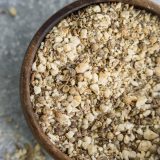Cauliflower has come of age in America, but it has been a part of the world’s culinary landscape for centuries, especially in the Levant—in Lebanon and Syria particularly. One of the most popular preparations is fried cauliflower. The meze dish goes by various names (arnabeet makli and zahra mekla, among others), and is served with a tahini-based sauce that also includes water, lemon and garlic.
The nutty, roasted flavor of the sesame paste seemed perfectly suited to the neutral taste of the cauliflower. At Milk Street, we chose roasting instead of frying; it’s easier and less messy.
So far so good, except the tahini sauce dripped off and burned on the pan. To make cleanup easier, we lined our baking sheet with foil. Then we swapped water in the sauce for oil, which helped browning and clung to the cauliflower better. Still, the sauce needed a bit more complexity. We added sweet paprika and cayenne and used both the zest and juice of a lemon.
Using florets sped up the roasting time and made for more even cooking. Heating the baking sheet in a very hot oven beforehand was crucial to getting the florets browned and just tender.
Out of the oven, the cauliflower needed a splash of lemon juice and some fresh cilantro to finish. We also thought the Egyptian nut-and-seed blend dukkah would be a nice addition. Though we liked it as a final touch, roasted, salted cashews were a simpler solution.
In India, there is garam masala and in China, five-spice powder. In Egypt, cooks have their own go-to seasoning— dukkah. It’s a blend of coarsely crushed toasted nuts and whole spices (think cumin, coriander and sesame seeds). Rich in protein and fats, the spice mix was peasant fare historically, used to season beans or bread. Today, Egyptians consume dukkah from morning to evening. Served alongside hard-cooked eggs, it’s breakfast. With oil, cheese and fresh bread, a snack. Sprinkled on roasted meat or vegetables, dinner. For our version, we used cashews instead of more traditional hazelnuts; it saved us from peeling the nuts after toasting. To the standard spice bill we added caraway seeds, which lent a slight bite. Dried oregano was the best substitute for the wild marjoram often found in Egyptian dukkah. Dukkah adds textural contrast to salads and vegetables (like our cauliflower with tahini), olive oil for dipping bread and roasted or grilled meat, chicken or fish.





